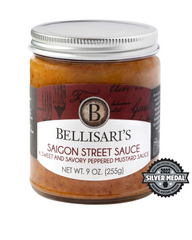I Like Big Batches and I Cannot Lie!

School’s almost out, which means it's time to celebrate – your graduates! Whether it’s high school or college, let them toss their caps in the air while you whip up some of our favorite party-ready graduation foods. If you plan on gathering with a crowd or just a small group, we've rounded up some favorite recipes that are delicious yet simple, can easily be made ahead of time, and maybe best of all, ones that are easy to multiply for big batches needed at a party. These ideas and options will help you pull off the best graduation party ever.
The future (and these delicious party foods) are possibly new on your graduate's horizon, but that doesn't mean it should be hard work getting your party ready. What could be easier than making a big batch of pulled pork and bowls full of crisp, cold coleslaw for our Pulled Pork Sandwiches with Saigon Slaw? Our French Macarons are always a hit and can be made in almost any color to match your school colors or party theme.
Celebrating for high schoolers or younger? A signature non-alcoholic party drink or mocktail could be fun for your graduates. A big batch of “Paul’s Punch” or “Libby’s Libation” would be a conversation starter for sure, and a creatively-named tasty beverage will be a detail that is remembered long in the future. If you're congratulating the 21+ crowd, the same could be done with big-batch cocktails, sure to please any partier.
But if you have a recipe that makes 6 servings, how do you change it to make 100 servings and still taste the way it’s supposed to? While it can sometimes be challenging, for the most part, modifying a recipe to change the number of servings it yields is a fairly common challenge. With some simple math, you can multiply your ingredients by the number you need and produce a deliciously successful result.
Adjusting the number of servings of a recipe is called scaling, and broadly speaking, it involves multiplying (to increase) or dividing (to decrease) the quantities of the individual ingredients in a recipe.
For instance, if you're making club sandwiches for 12 people, and your recipe makes 2 sandwiches, you'd simply multiply every ingredient times 6: the slices of bread, the mayonnaise, the turkey, and so on. You might have to convert the quantities, so that 24 tablespoons of mayonnaise becomes a more comprehensible 1 1/2 cups, but it's all pretty simple. Obviously, not everyone uses a recipe to make sandwiches, but the example helps to illustrate a fairly straightforward case.
For the party foods I’m suggesting here, perhaps batching vs. doubling or scaling is what would be easiest. An alternative to scaling is to cook in batches. This means that instead of doubling the size of a casserole, you'd simply make as many separate casseroles of the original size that you need and bake them at the same time. They might take a bit longer to cook due to the more crowded oven, but not significantly more.
Converting recipes can sometimes be a daunting task. It starts when you find a recipe you like, but it's not in the correct portion you need. To scale it up to make more servings you might need:
- Equipment changes: You may need larger pans and more cook space for instance.
- Evaporation and thickening agents should be considered
- Tempering ingredients: With a larger portion size, you may need to thaw longer during the preparation.
- Cooking times may need to be adjusted
That’s why I suggest that you don’t always need to scale a recipe! It is often safer (though often more time consuming too) to cook in batches. So, instead of doubling a recipe, you can always make the recipe once, then clean your workspace and make it again, reassuring yourself that everything is in the right ratios and you have all the servings you’ll need. Congratulations to the Class of 2022 from all of us at Bellisari’s!






